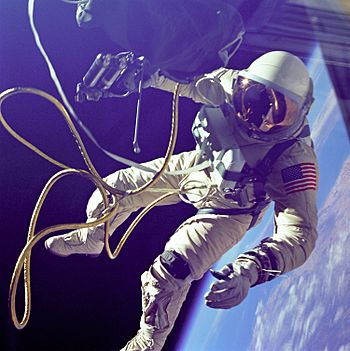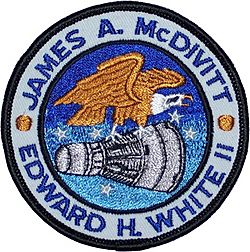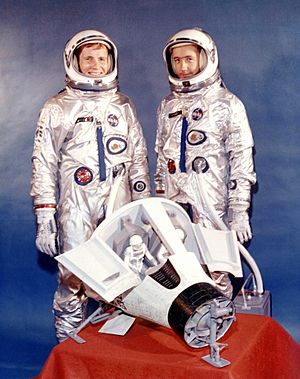Gemini 4 facts for kids

Ed White, the first American to perform extravehicular activity, outside of Gemini IV
|
|
| Operator | NASA |
|---|---|
| Mission duration | 4 days, 1 hour, 56 minutes, 12 seconds |
| Distance travelled | 2,590,600 kilometers (1,398,800 nautical miles) |
| Orbits completed | 66 (62 revolutions) |
| Spacecraft properties | |
| Spacecraft | Gemini SC4 |
| Manufacturer | McDonnell |
| Launch mass | 3,570 kilograms (7,880 lb) |
| Crew | |
| Crew size | 2 |
| Members |
|
| EVAs | 1 |
| EVA duration | 20 minutes |
| Start of mission | |
| Launch date | June 3, 1965, 15:15:59 UTC |
| Rocket | Titan II GLV, s/n 62-12559 |
| Launch site | Cape Kennedy LC-19 |
| End of mission | |
| Recovered by | USS Wasp |
| Landing date | June 7, 1965, 17:12:11 UTC |
| Landing site | North Atlantic Ocean 27°44′N 74°11′W / 27.733°N 74.183°W |
| Orbital parameters | |
| Reference system | Geocentric |
| Regime | Low Earth orbit |
| Perigee | 165 kilometers (89 nmi) |
| Apogee | 289 kilometers (156 nmi) |
| Inclination | 32.5 degrees |
| Period | 89.03 minutes |
| Epoch | June 3, 1965 |
  (L-R) White, McDivitt |
|
Gemini 4 was NASA's second crewed space mission in the Gemini program. It happened in June 1965. It was the tenth time Americans flew into space. Astronauts James McDivitt and Ed White orbited Earth 66 times over four days. This was the longest American spaceflight at the time, getting close to the Soviet Union's record.
The most exciting part of the mission was the first spacewalk by an American. Ed White floated freely outside the spacecraft for about 20 minutes, connected by a tether.
The mission also tried to perform the first space rendezvous. McDivitt tried to fly the spacecraft close to the Titan II rocket's upper part that launched them. However, this attempt was not successful.
Gemini 4 was also the first American flight to do many science experiments in space. One experiment used a sextant to practice celestial navigation for future Apollo missions to the Moon.
Contents
Meet the Crew
| Position | Astronaut | |
|---|---|---|
| Command Pilot | James A. McDivitt First spaceflight |
|
| Pilot | Edward H. White II Only spaceflight |
|
Backup Crew Members
| Position | Astronaut | |
|---|---|---|
| Command Pilot | Frank F. Borman II | |
| Pilot | James A. Lovell, Jr. | |
Support Team on Earth
- Virgil I. "Gus" Grissom (Houston CAPCOM)
- Roger B. Chaffee (CAPCOM)
- Eugene Cernan (CAPCOM)
The First American Spacewalk
- Astronaut: Ed White
- Date: June 3, 1965
- Hatch opened: 7:34 PM UTC
- Spacewalk started: 7:46 PM UTC
- Spacewalk ended: 8:06 PM UTC
- Duration: 20 minutes
- Hatch closed: 8:10 PM UTC
What Were the Goals of Gemini 4?
Gemini 4 was the first multi-day space flight for the United States. Its main goal was to show that humans could stay in space for a long time. This was important because a trip to the moon and back would take many days.
Another goal for the four-day, 62-orbit mission was to try a space rendezvous. This meant Gemini 4 would try to fly very close to the empty second stage of its Titan II rocket.
The mission also aimed for the first American spacewalk (EVA). NASA moved this up after Soviet cosmonaut Aleksei Leonov did the first-ever spacewalk in March. The US wanted to show it was not falling behind in the Space Race.
Gemini 4 set a new record for how long a US space mission lasted. It also helped calm worries about how long missions might affect astronauts' health. This flight was also the first to use the new Mission Control center near Houston. Because the flight was so long, the control center had to work in three shifts.
The Flight Journey
Launch Day
The launch of Gemini 4 was a big event for television. For the first time, people in twelve European countries could watch the launch live. This was possible thanks to the Early Bird satellite. Many reporters wanted to cover the event. NASA had to rent extra buildings for the 1,100 journalists who came.
The launch itself went perfectly, except for a few moments of slight shaking. The spacecraft entered an orbit of 163 by 282 kilometers around Earth.
Trying for a Space Rendezvous
On the first orbit, the astronauts tried to meet up with the rocket's spent second stage. This attempt taught space engineers a lot about how things move in orbit. The astronauts found it hard to aim for the stage because they couldn't tell how far away it was. When they fired their thrusters to get closer, they actually moved away. This happened because a vent on the stage opened, causing it to move around.
After several tries, and with half their fuel used, McDivitt and White decided to stop. They agreed with Mission Control that the spacewalk was more important. They knew the rendezvous could be tried on later missions. (Future missions learned to first drop to a lower, faster orbit before rising to meet another object.)
Science Experiments in Space
Gemini 4 carried eleven different experiments.
- Radiation Measurement: Five special devices measured radiation inside the spacecraft. They were especially interested in an area called the South Atlantic Anomaly.
- Space Navigation: The crew used a sextant to practice finding their position using the stars. This was important for future Moon flights.
- Photography: Two experiments involved taking pictures. The astronauts used a 70-millimeter Hasselblad camera to photograph weather and land below them.
- Medical Checks: There were two medical experiments. One used a bungee cord for exercise. The crew said it got harder to use as the mission went on, possibly due to lack of sleep. The other experiment used sensors on their bodies to measure their heart rates. This was especially important during launch, the spacewalk, and landing.
- Engineering Tests: Four experiments focused on engineering. One measured the electric charge in the spacecraft. Another used a proton-electron spectrometer. A third used a tri-axis magnetometer. The last one involved photographing the Earth's red-blue edge.
The spacecraft's computer stopped working on the 48th orbit. This was a bit embarrassing for IBM, which had just advertised how reliable its computers were. Because the computer failed, the capsule could not perform a special "lifting reentry" as planned.
Coming Back to Earth
The spacecraft began its return to Earth on the 62nd orbit. Because the computer failed, they used a simpler "rolling reentry," like the one used in the Mercury program. The astronauts started rolling the spacecraft at 120,000 meters high to make it more stable. They slowed the roll at 27,000 meters and stopped it by 12,000 meters.
A small drogue parachute opened shortly after, and the main parachute opened at 3,230 meters. A thruster that wasn't working right made the roll much faster than planned, leading to a rough landing. However, both astronauts were fine. This was good news for NASA doctors, who worried about astronauts landing upright after four days in space. Even though they landed 80 kilometers short of the target, ships were already heading to the area. A helicopter even saw them land.
The US Department of Defense helped with the Gemini 4 mission. They provided 10,249 people, 134 aircraft, and 26 ships.
Mission Patch and Name
The Gemini 4 crew first wanted to name their spacecraft American Eagle. But NASA leaders said no. They didn't want a repeat of the previous mission, where Gus Grissom had named his spacecraft Molly Brown.
So, the mission was simply called Gemini 4. There was no official patch worn on the crew's suits during the flight. The patch you see today was made later and is on display in McDivitt's museum. Since they couldn't name their spacecraft, the crew decided to put the American flag on their suits. Surprisingly, they were the first US astronauts to do this. Soviet crews had already used "СССР" (USSR) on their helmets. Before Gemini 4, US astronauts only had the NASA logo and their name on their suits.
Where to See the Spacecraft
The Gemini 4 spacecraft is on display at the National Air and Space Museum in Washington, D.C..
Images for kids
-
White (l) and McDivitt being congratulated by President Lyndon B. Johnson by telephone aboard the aircraft carrier USS Wasp
See also
 In Spanish: Gemini 4 para niños
In Spanish: Gemini 4 para niños





